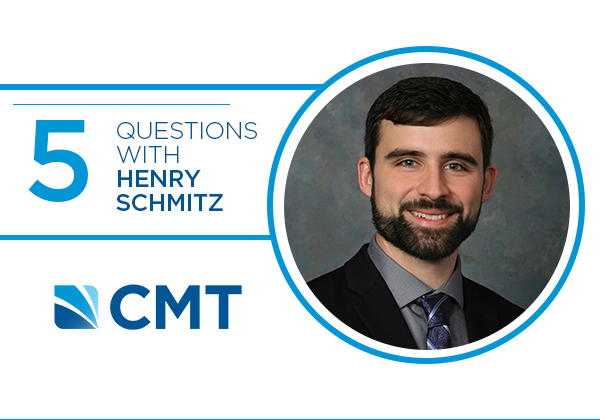Henry Schmitz, PE, CFM is a civil engineer who is passionate about using his technical skills to equitably advance people’s quality of life. His career has focused on water resources and drainage. This has included design experience for pump stations, excess flow treatment facilities, and sewer improvements, as well as collection system and stormwater studies. Henry’s skill-building and calibrating hydraulic and hydrologic models has led to stormwater experience across all of CMT’s business units. Henry holds a bachelor’s degree in civil and environmental engineering from the University of Illinois Urbana-Champaign. He is a member of CMT’s Quality of Life Community of Practice and is based in our Springfield, IL, office.
How did you first become interested in civil engineering?
I started school at the University of Illinois focused on materials science, but after a couple semesters, I started thinking that wasn’t what I wanted to do. Around that time, I took an elective geography class called “Contemporary Social and Environmental Issues.” During that course, the professor gave a presentation about the Aral Sea, a massive inland sea that essentially dried up due to overuse for irrigation. It just blew me away that people could have such a massive, negative impact on a body of water that size.
Thinking back on it now, I’ve always had a fascination with bodies of water. My family would go camping near the Kaskaskia River in southern Illinois every summer, and I would notice how the river would change from year to year. A sandbar that was there one year would be gone the next, and that was always really interesting to me.
So, my underlying interest was there, but the presentation on the inland sea really intrigued me and made me want to get involved in preventing these sorts of negative things from happening to water and water resources. I researched which degrees would provide me with the opportunity to do that kind of work, and I found civil engineering would be the best fit. As a civil engineering major, I was able to work with some incredible professors and take some really enjoyable classes, and I haven’t looked back.
What kind of work do you find to be most fulfilling, and why?
To me, the title “civil engineer” connotes the responsibility and civic duty of providing infrastructure to everyone in our communities. I’m drawn to that definition, so I like projects that improve quality of life by eliminating or reducing flooding – particularly for people who have come to think of frequent flooding or sewage backups as a part of life. That shouldn’t be the case.
I’ve had first-hand experience living in places where the basement floods after large rains, and it just ruins your day or week. People who face these flooding challenges have to make sure everything in the basement is always stored in plastic boxes. There’s the smell and cleanup afterwards, plus the possibility of disease, illness, and all the other stuff that comes along with it.
So for me, the most fulfilling projects are those that eliminate flooding in people’s homes, improve their standard of living, and bring equity to their lives.
What drew you to CMT’s Quality of Life Community of Practice?
I was invited to join the group after having a conversation with a Community of Practice member about inequities in infrastructure and my interest in being part of the solution.
For many of us, it’s easy to take for granted that plumbing and sewers will work as they’re expected to. But for some communities, flash flooding and terrible sewage backups have become normal.
One of the great things about the field of civil engineering is getting the chance work on projects that narrow the gap in the quality of infrastructure. I’ve just joined the Quality of Life group but am excited to listen, learn, share my perspective, and see how we can work together on providing equitable infrastructure solutions.
Who are some of your mentors at CMT, and how have they supported your career growth?
Tim Sumner has been a project manager on a lot of the projects I’ve worked on, and he’s taught me a lot about how to stay organized, especially for projects with many stakeholders and lines of communication. I will never claim to be as organized as Tim, but it’s something to strive for.
Both Tim and Christy Crites have given me a lot of opportunity to be in client-facing roles. They put trust in me before I was sure I was ready, putting their faith in me to be the one with the answers. Knowing they had confidence in me made all the difference in my ability to grow into those client-facing roles.
In addition, Christy has always welcomed my ideas and made sure to give me the support I need for whatever direction I’d like to take my career in.
There are too many others to name – I get a lot of help from people at CMT every day. I always have questions for colleagues, and they are always there to lend a hand.
What do you value most about CMT’s company culture?
For me, something that stands out about the culture is the support I’ve received around my interests as they’ve evolved over time. Where I am today in my career is probably not what the company envisioned when they hired me. I imagine their expectation was that I’d be doing more wastewater treatment design. But over time, I’ve communicated the kinds of projects I’m drawn to, and my leaders could see what I was excited about. When it was clear that flooding-type projects and computer modeling of sewer systems really sparked my interest, they supported that shift.
It’s great to be part of a culture and have leadership that supports all the little branches in my career path – always giving me the opportunity to evolve and find the next challenging, exciting thing.





